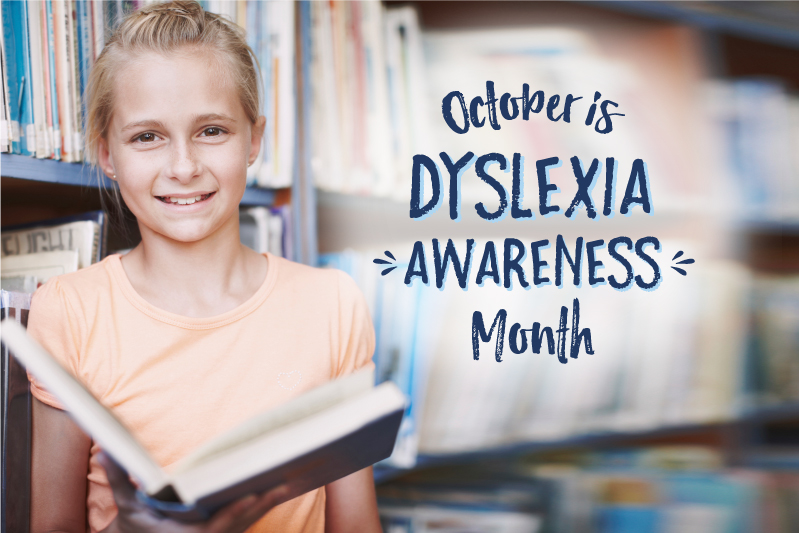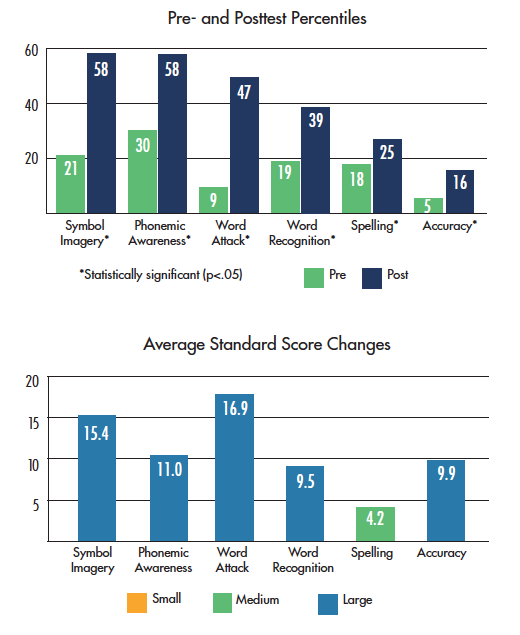For Dyslexia Awareness Month we are sharing our belief that all individuals can be taught to read to their potential—including those who have a previous diagnosis of dyslexia.
Over the course of nearly three decades, Lindamood-Bell has worked with thousands of individuals. Sitting with a child or an adult who struggles to read a word provides unique insight into the learning process. Our success with students is due to our unique approach, including our research-validated, sensory-cognitive instruction.
Learning Center Results: Students With Dyslexia
We internally monitor the results for students at our learning centers and school partnerships to ensure our exceptional standard of quality. At Lindamood-Bell Learning Centers, students receive individualized instruction, utilizing one or more of our research-validated programs. Our Seeing Stars program addresses the needs of many students who have been previously diagnosed with dyslexia. On average, students with dyslexia who received Seeing Stars instruction at our learning centers achieved significant improvements in reading. They made large (significant) standard score changes on nearly all measures. The 38-point percentile increase in word attack put these students well within the normal range (25th–75th percentile). The large average standard score change in word recognition should be noted, as students now performed within the normal range on this measure. Their pre- to posttest results were statistically significant on all measures.
Students With Dyslexia Who Received Decoding Instruction
Years: 2008-2015
Number of Students: 1,234
Average Age: 10
Average Hours of Instruction: 110
Lindamood-Bell Instruction Implemented: Seeing Stars
View results for students with other diagnoses, such as ADHD, here.
Peer-reviewed Research: Changes to Brains of Dyslexic Students After Lindamood-Bell Instruction
We actively participate in peer-reviewed studies of our programs and instruction. Numerous peer-reviewed articles based on studies examining the effectiveness of the Lindamood-Bell programs with dyslexic students have been published in scholarly journals.
In one such study, researchers at Wake Forest University and the Child Study Center at Georgetown University, published conclusions about the effects of Lindamood-Bell instruction on the brain activity and reading ability of dyslexic students.
This research noted significant improvements in reading associated with gray matter volume increases following Seeing Stars instruction with dyslexic students—and the neurological changes held or increased after the intervention. To view the results and download the study: click here.
More independent research on the effect of Lindamood-Bell programs with students previously diagnosed with dyslexia can be found here.
Why hasn’t my dyslexic child experienced growth with other programs?
When a student has been diagnosed with dyslexia, extra help typically focuses on phonics, or sounding out words, and spelling rules. Unfortunately, many students, even those who have had years of extra help, continue to struggle with grade level text.
Perhaps they sound out a word eventually—but it is slow and labored. They may take so long to sound out the word that they miss the meaning of the text altogether. Or, they may substitute words when reading a paragraph. For example, they may read ‘production’ instead of ‘perfection.’
For many individuals, even those who have received extensive reading support, sight word recognition remains difficult. They may attempt to use phonics strategies for most words—such as reading /pee/ /oh/ /plee/ for the word ‘people.’ When they finally conquer a word, they might not recognize that same word when they encounter it in the next paragraph.
Also, while a student may be able to spell words phonetically, they are unable to remember the visual patterns of words (orthography). For example, they may spell the word “friend” as “f-r-e-n-d.”
What is the missing connection for these students?
An important aspect of reading and spelling is symbol imagery, which underlies both phonological and orthographic processing. Symbol imagery is the ability to visualize letters in your mind’s eye. This connection of imagery and language is necessary for sounding out new words, as well as quickly recognizing letters and common words.
Students who read fluently, and are able to self-correct their errors, have strong symbol imagery.
Traditional reading help focuses on how to sound out words as well as reading and spelling rules. While these activities have value, they do not affect the necessary imagery-language connection. They do not change how a student is processing language. This is why reading may still be extremely difficult for a child.
We help make this connection for students at our learning centers. Our teachers’ language stimulates an individual’s symbol imagery. For example, when a teacher says, “What letters do you see for ‘top’?” she is prompting the student to picture the letters t-o-p. By applying this skill to phonological and orthographic processing, reading and spelling skills are improved.
Improved symbol imagery changes how a student reads and spells, regardless of their age or struggle with literacy—including those with a previous diagnosis of dyslexia.
Learn how symbol imagery can change learning—Seeing Stars Program: Symbol Imagery for Phonological and Orthographic Processing for Reading and Spelling.
If you would like further information or have questions regarding our instruction for students with a previous diagnosis of dyslexia, please contact us at 800.300.1818.
NPR series Unlocking Dyslexia features Lindamood-Bell
Our approach is featured in several stories of the the NPR series, Unlocking Dyslexia.
The series includes Millions Have Dyslexia, Few Understand It. The reporter, who was a student at Lindamood-Bell when she was younger, visited our Washington, DC Learning Center this past summer and interviewed Center Director Nancy Gregerson and some of our students. Our students and their families were also interviewed for the piece, How Parents Can Help Kids With Dyslexia Succeed In School.
In How Science Is Rewiring The Dyslexic Brain, Guinevere Eden, director of Georgetown University’s Center for the Study of Learning, explains what is happening in the brain of someone with dyslexia when they read and how the brain can be “rewired” with intensive intervention. Instruction using the Seeing Stars program is featured.
Get the series here.







